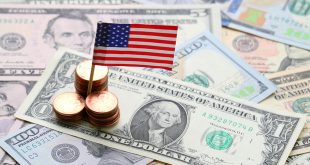The US dollar ended last week’s trading with losses. The dollar index, which measures the US currency against a basket of major currencies, fell to 95.48 points, compared to 97.13 points posted last week.
The Bank of England announced its monetary policy decision on Thursday and raised the benchmark interest rate by 25bps to 0.50%. The Monetary Policy Committee (MPC) voted 5-4 in favor of a 25 bps rate hike. The decision was in line with market expectations and marked the first back-to-back rises since 2004.
The European Central Bank opted to leave its deposit rate unchanged at -0.5% on Thursday as unanimously expected. However, the bank maintained its guidance on interest rates, saying they would remain at present or lower levels until the conditions for a rate hike have been met.
Wall Street
The S&P500 and Nasdaq jumped on Friday, ending their best week of the year, as continued strength in earnings reports extended a tech-led recovery from January’s losses.
The Nasdaq rose 1.6 percent to 14,098.01 and the Dow Jones Industrial Average fell 21.42 points, or 0.06 percent, to 35,089.74.
During the week, the S&P 500 was up 1.5%, and the Nasdaq was up 2.4%.
The Dow ended the week up 1.1%.
These gains represent the second of the 2022 weekly increases for indices that came under pressure last month as fears of higher interest rates drove down tech names.
Amazon led the gains of the S&P500 and Nasdaq, which jumped 13.5 percent on strong quarterly earnings and fluctuating cloud revenue.
Friday’s rally was also Amazon’s biggest one-day gain since 2015.
Snapshot up 58.8%, the day after earnings were reported.
Pinterest stock rose 11.2%.
Europe
European markets closed in negative territory on Friday as investors digested the major updates from the Bank of England and the European Central Bank the previous day.
The pan-European Stoxx 600 closed 1.42% lower, with only the oil and gas sector in positive territory, and the index fell over the week by 1.85%.
Auto stocks led the losses, declining by 3.34%.
New data on Friday revealed that UK new car sales last month were 23% below pre-pandemic levels.
The European Central Bank announced yesterday that it would keep interest rates unchanged despite record inflation levels across the Eurozone.
However, the Bank of England raised interest rates in the first consecutive rate increase since 2004.
The European Central Bank has resisted pressure to raise interest rates at a time of unprecedented inflation, with the latest reading hitting a record high of 5.1% last month.
Oil
Oil prices jumped to their highest level in seven years on Friday, continuing their rise for a seventh week, as fears of supply disruptions persisted, fueled by cold weather in the United States and political turmoil among the world’s major producers.
Brent crude futures rose $2.16, or 2.4 percent, to settle at $93.27 a barrel, after earlier touching the highest level since October 2014 at $93.7 a barrel.
US West Texas Intermediate crude futures rose $2.04, or 2.3%, to settle at $92.31 a barrel, after trading as high as $93.17, the highest price since September 2014.
Brent crude ended the week up 3.6%, while West Texas Intermediate crude recorded a 6.3% increase, their largest increase since October.
On Thursday, a severe winter storm swept the central and northeastern United States, cutting power for thousands of families.
Oil prices also rose due to the tension related to the Ukraine crisis, which has fueled concerns about already limited oil supplies.
Gold
Gold prices rose at the end of trading Friday, February 4th, as rising inflation fears helped ease the pressure of the dollar’s rise and the rise in US Treasury bond yields after surprisingly positive US jobs data.
And gold futures rose by 0.2% to $ 1808.9 an ounce, to record the precious metal, an increase of about 1% during the week.
Gold prices rose with the dollar’s decline during Friday’s trading, ahead of the jobs data, which markets expect to affect the Fed’s tendency to tighten monetary policy.
Earnings
Meta’s earnings fell short of expectations for the fourth quarter, and the company said many challenges lie ahead in the first quarter.
Earnings per share amounted to about $3.67, compared to an expected $3.84, while revenues amounted to $33.67 billion, compared to an expected $33.4 billion.
Daily active users reached 1.93 billion vs. 1.95 billion expected, while monthly active users reached 2.91 billion vs. 2.95 billion expected.
Amazon posted a significant profit outperformance for the fourth quarter, buoyed by gains from its investment in electric vehicle company Rivian.
The company also revealed revenues from its fast-growing advertising business for the first time.
On Thursday, Amazon said revenue jumped 9% last quarter, and the company reported a gain of about $12 billion from its investment in electric car company Rivian.
Earnings per share amounted to $5.80 versus $3.57 expected, while revenue reached
 Noor Trends News, Technical Analysis, Educational Tools and Recommendations
Noor Trends News, Technical Analysis, Educational Tools and Recommendations





